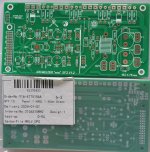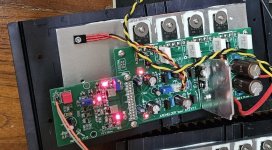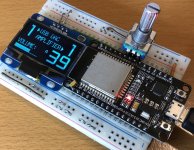Why don't we create a fully integrated amp for the lounge, listening room or desktop with all the features that one could want. Maybe a single PCB or modular to chop and change to suit your requirement. Maybe include things like headphone out, maybe even integrate one of the DACs presented on the forum. I am tired of all the different boxes, each having a power supply chassis, etc. Is fully integrated bad and if so what makes it worse than a dozen boxes staked on your desk.
Don't we want to twiddle knobs and change the bass and treble, switch between sources without adding another box. Have a loudness contour for those evenings when the kids are asleep, make something sounding good as well as pleases the eye.
Establish a design committee, Not dictating but compliant to everyone's input.
We need to start with some basis requirement of what we want it to be. A functional requirement. So guys and dolls, don't be shy.
My amp in 1973 this started my hobby. It was beautiful, functional and exciting. So lets list what we want and start off...

The above reminds me of times past, when knobs were big and toggle switches for every possible option were the norm. I'm looking forward to a design that has some 'different' bass/treble solution, maybe something along the lines of Quad's contour solution.
This amp starter my career as electronic engineer and I always had the desire to create something as stunningly beautiful and functional. But this will be a group attempt. All of us sharing our likes dislikes our experience and schematics that will become our hi-fi amp. For instance, I would like at least 60 watt per channel (maybe more). I think we can all contribute by offering our working products and then choose one to fit our needs for this amp. There is no point in starting designing new circuits, we use the best that is available on DIY.
There may be PCB designs involved to integrate different modules and make the wiring plug and play.
There may be PCB designs involved to integrate different modules and make the wiring plug and play.
We should be allowed to collectively vote on a design for each module and those who can, can run simulations and inform the rest of the most suitable for the collective application. So no, it will probably not be ready this Saturday. My role will be mainly to facilitate, not indoctrinate. The options are whatever you want to do. Below is an elaborate pre-amplifier it went to the extent that different sections had their own PSU, it was a R2R volume control, etc, etc. The volume had LED indication on it. There was a PIC and so on, thus there is no limit to build the best of the best that can come out of DIYaudio.
An example only:

An example only:
Last edited:
Ok, so let's run up a set of questions as to what to include, types of input, remote?, tone/no tone, volume control method (digital / analogue), display, output power, protection? That's a start.
Besides, if possible I would like each one that contributes to maybe make a few bucks from it, like fabricating a chassis, face plate. sourcing knobs, getting components in volumes, all kind of possibilities for those that wants to. Let have this thread open for comment and suggestion. Collectively we probably have one of the biggest engineering compliment of most hi-end audio companies, let utilise it to our own benefit.
Some of you may be product designers that can develop different facia panels that include or exclude options, such as someone who does not want tone controls, or speaker selector, etc. We should also design for a plug and play wiring harness that everything sits on a "bus" and modules can be inserted or omit as the user sees fit or may want to start a basic system that he/she may want to include other options later.
For instance, maybe (Andrew) Bonzai wants to offer a phono pre-amp to include, Mooly offers his simple but rather nice Op-amp + Mosfet output stage and so on. We don't want to redesign the wheel, just use it and make it better. I have some ideas for output protection, etc. Come one guys show your wealth of projects. Maybe even have a few output amps to choose from for your particular application, class A, AB etc. There is no limit really, just consensus.
So, its a commercial endeavour after all?Besides, if possible I would like each one that contributes to maybe make a few bucks from it,
//
Would like to know from the moderators, can a topic be split in more threads maybe? Say the selector, the R2R volume, the output stage etc?
Okay I will wait and see how this thread develops. Nice of you to join in.
Okay I will wait and see how this thread develops. Nice of you to join in.
Last edited:
I won't join in, but I just have two comments:
1. A clipping detector that lights up for a second or so when the amplifier clips for a few microseconds is a very useful feature. If it never lights up during normal use, it keeps you from worrying about whether you have enough power.
2. After tweaking the time.constants a bit, the bass part of the tone control L. V. Viddeleer published in the late 1940's and early 1950's can approximate the differences between ISO 226:2003 equal loudness contours reasonably well. It is therefore useful as a loudness-derived tone control. The original circuit requires a really big inductor, but you can also emulate that.
Edit:see https://www.diyaudio.com/community/threads/loudness-controls.214490/post-5786913
and posts #11 and #12 of https://www.diyaudio.com/community/...ether-it-works-in-a-or-ab.308636/post-5100509 (never actually built or debugged)
1. A clipping detector that lights up for a second or so when the amplifier clips for a few microseconds is a very useful feature. If it never lights up during normal use, it keeps you from worrying about whether you have enough power.
2. After tweaking the time.constants a bit, the bass part of the tone control L. V. Viddeleer published in the late 1940's and early 1950's can approximate the differences between ISO 226:2003 equal loudness contours reasonably well. It is therefore useful as a loudness-derived tone control. The original circuit requires a really big inductor, but you can also emulate that.
Edit:see https://www.diyaudio.com/community/threads/loudness-controls.214490/post-5786913
and posts #11 and #12 of https://www.diyaudio.com/community/...ether-it-works-in-a-or-ab.308636/post-5100509 (never actually built or debugged)
Last edited:
I'd volunteer (my) small version of the Badger /wolverine - https://www.diyaudio.com/community/...smd-60w-amps-wolverine-compatible-ips.398785/ .
Real small (100W - 150 peak) with LOTS of options. PPM versions of ADCOM /wolverine/leach , your choice. Input stage can be put out on a floppy cable (modular) .
Best if you keep the thread in one piece . The main amp , pre-headphone linestage , supply , and controller (volume-input) all have to work
together. All their designs would be symbiotic to the a quality end product.
OS
Real small (100W - 150 peak) with LOTS of options. PPM versions of ADCOM /wolverine/leach , your choice. Input stage can be put out on a floppy cable (modular) .
Best if you keep the thread in one piece . The main amp , pre-headphone linestage , supply , and controller (volume-input) all have to work
together. All their designs would be symbiotic to the a quality end product.
OS
Attachments
Remote control 20 band software controlled (OLED) with display. Run with a ESP32 !Don't we want to twiddle knobs and change the bass and treble, switch between sources without adding another box. Have a loudness contour for those evenings when the kids are asleep, make something sounding good as well as pleases the eye.
PS - smartphone = remote.
OS
Attachments
Last edited:
< Is fully integrated bad and if so what makes it worse than a dozen boxes staked on your desk.>
- Fully integrated means high commitment to produce a complex product which may have some bugs
- Modular means being able to fix or improve a part without compromising the whole
- Integrated might have better performance with lower noise
Okay, the list begins:
1. Clipping indicator
2. Loudness control
3. Output Protection
4. 60 watt/ch
5. Low distortion <0.01%
6. Bass& Treble
7. RCA inputs: a) DAC in, b) Aux 1, c) Aux2
8. Headphone out
10. Volume Potentiometer
11. Remote control
1. Clipping indicator
2. Loudness control
3. Output Protection
4. 60 watt/ch
5. Low distortion <0.01%
6. Bass& Treble
7. RCA inputs: a) DAC in, b) Aux 1, c) Aux2
8. Headphone out
10. Volume Potentiometer
11. Remote control
- Home
- Amplifiers
- Solid State
- Why not design and build a fully integrated amp for your desktop or listening room


